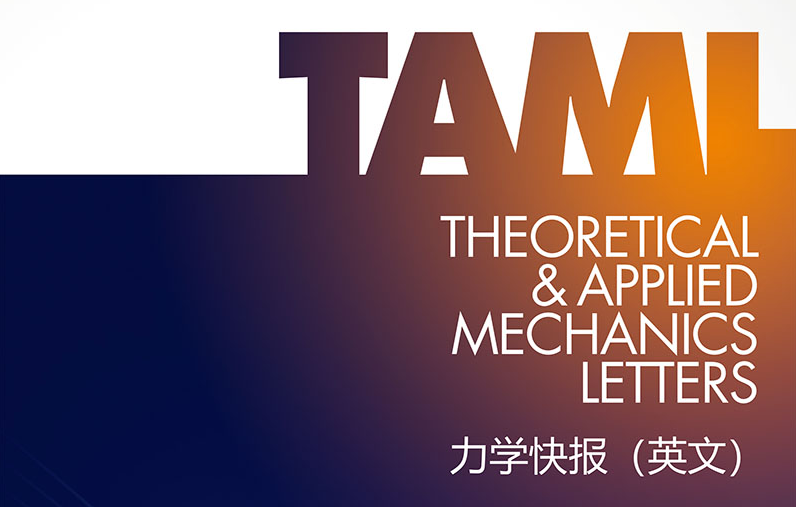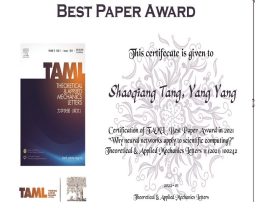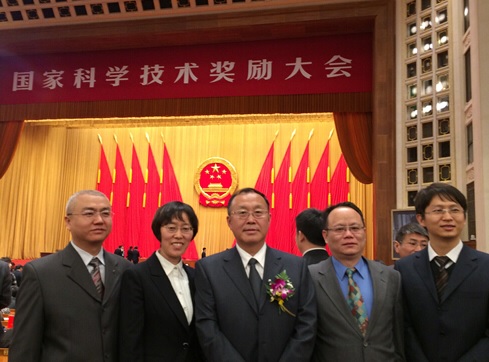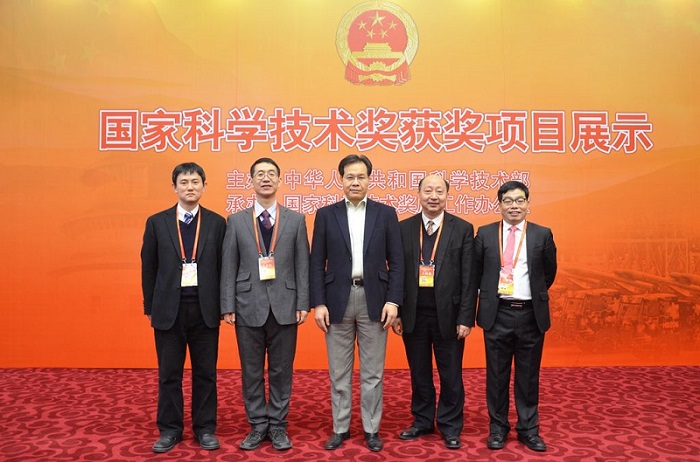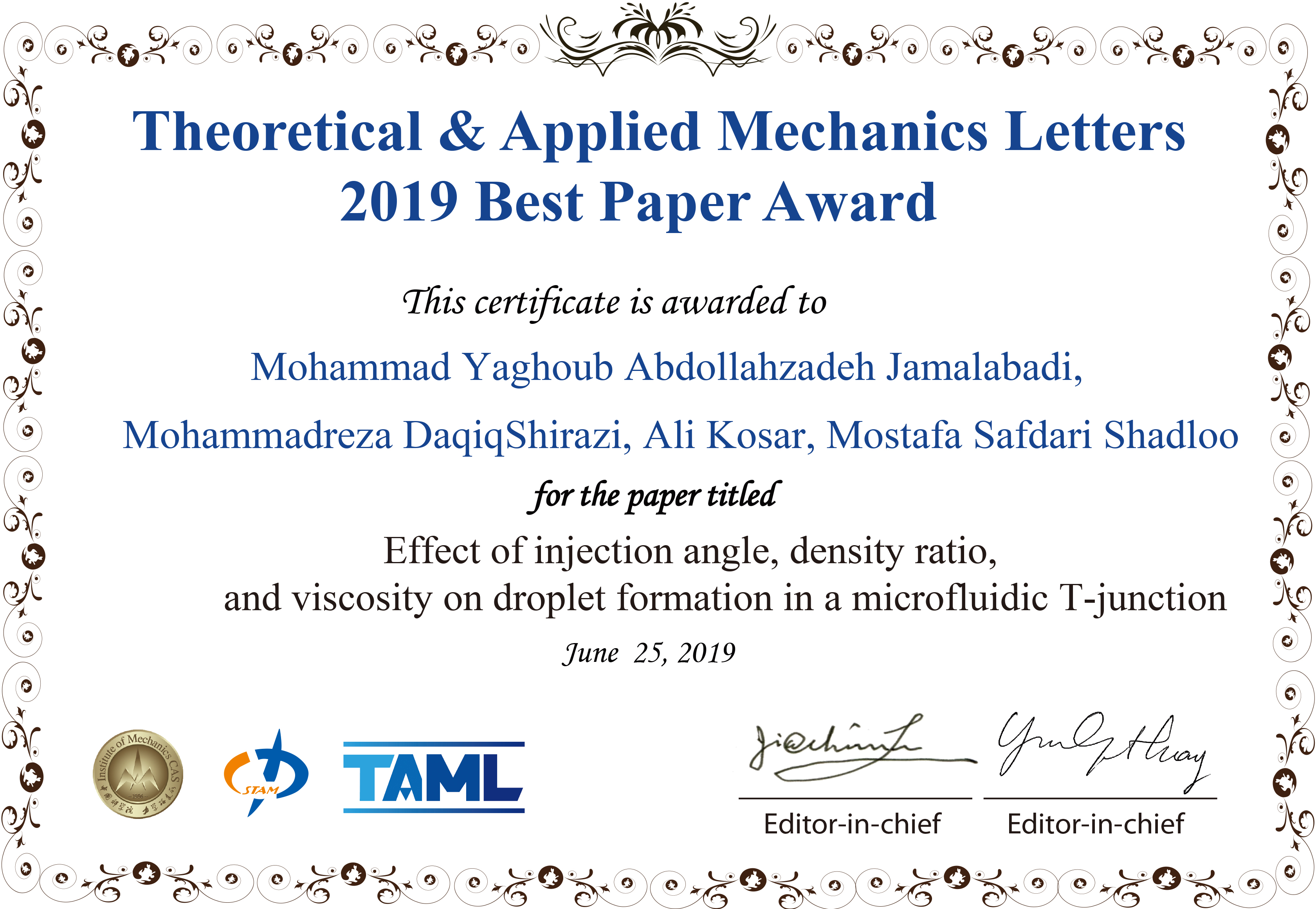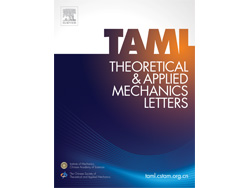Institute of Mechanics,
Chinese Academy of Sciences
2025 Vol.15(1)
Theoretical and Applied Mechanics Letters 15 (2025) 100500.
doi: 10.1016/j.taml.2024.100500
Abstract:
The introduction of wireless capsule endoscopy has brought a revolutionary change in the diagnostic procedures for gastrointestinal disorders. Biopsy, an essential procedure for disease diagnosis, has been integrated into robotic capsule endoscopy to augment diagnostic capabilities. In this study, we propose a magnetically driven biopsy robot based on a Kresling origami. Considering the bistable properties of Krelsing origami and the elasticity of the creases, a foldable structure of the robot with constant force characteristics is designed. The folding motion of the structure is used to deploy the needle into the target tissue. The robot is capable of performing rolling motion under the control of an external magnetic drive system, and a fine needle biopsy technique is used to collect deep tissue samples. We also conduct in vitro rolling experiments and sampling experiments on apple tissues and pork tissues, which verify the performance of the robot.
The introduction of wireless capsule endoscopy has brought a revolutionary change in the diagnostic procedures for gastrointestinal disorders. Biopsy, an essential procedure for disease diagnosis, has been integrated into robotic capsule endoscopy to augment diagnostic capabilities. In this study, we propose a magnetically driven biopsy robot based on a Kresling origami. Considering the bistable properties of Krelsing origami and the elasticity of the creases, a foldable structure of the robot with constant force characteristics is designed. The folding motion of the structure is used to deploy the needle into the target tissue. The robot is capable of performing rolling motion under the control of an external magnetic drive system, and a fine needle biopsy technique is used to collect deep tissue samples. We also conduct in vitro rolling experiments and sampling experiments on apple tissues and pork tissues, which verify the performance of the robot.
Theoretical and Applied Mechanics Letters 15 (2025) 100520.
doi: 10.1016/j.taml.2024.100520
Abstract:
The numerical simulation of the fluid flow and the flexible rod(s) interaction is more complicated and has lower efficiency due to the high computational cost. In this paper, a semi-resolved model coupling the computational fluid dynamics and the flexible rod dynamics is proposed using a two-way domain expansion method. The governing equations of the flexible rod dynamics are discretized and solved by the finite element method, and the fluid flow is simulated by the finite volume method. The interaction between fluids and solid rods is modeled by introducing body force terms into the momentum equations. Referred to the traditional semi-resolved numerical model, an anisotropic Gaussian kernel function method is proposed to specify the interactive forces between fluids and solid bodies for non-circle rod cross-sections. A benchmark of the flow passing around a single flexible plate with a rectangular cross-section is used to validate the algorithm. Focused on the engineering applications, a test case of a finite patch of cylinders is implemented to validate the accuracy and efficiency of the coupled model.
The numerical simulation of the fluid flow and the flexible rod(s) interaction is more complicated and has lower efficiency due to the high computational cost. In this paper, a semi-resolved model coupling the computational fluid dynamics and the flexible rod dynamics is proposed using a two-way domain expansion method. The governing equations of the flexible rod dynamics are discretized and solved by the finite element method, and the fluid flow is simulated by the finite volume method. The interaction between fluids and solid rods is modeled by introducing body force terms into the momentum equations. Referred to the traditional semi-resolved numerical model, an anisotropic Gaussian kernel function method is proposed to specify the interactive forces between fluids and solid bodies for non-circle rod cross-sections. A benchmark of the flow passing around a single flexible plate with a rectangular cross-section is used to validate the algorithm. Focused on the engineering applications, a test case of a finite patch of cylinders is implemented to validate the accuracy and efficiency of the coupled model.
Theoretical and Applied Mechanics Letters 15 (2025) 100521.
doi: 10.1016/j.taml.2024.100521
Abstract:
Nonlinear energy transfer is represented through eddy viscosity and stochastic forcing within the framework of resolvent analysis. Previous investigations estimate the contribution of eddy-viscosity-enhanced resolvent operator to nonlinear energy transfer. The present article estimates the contribution of stochastic forcing to nonlinear energy transfer and demonstrates that the contribution of stochastic forcing cannot be ignored. These results are achieved by numerically comparing the eddy-viscosity-enhanced resolvent operator and stochastic forcing with nonlinear energy transfer in turbulent channel flows. Furthermore, the numerical results indicate that composite resolvent operators can improve the prediction of nonlinear energy transfer.
Nonlinear energy transfer is represented through eddy viscosity and stochastic forcing within the framework of resolvent analysis. Previous investigations estimate the contribution of eddy-viscosity-enhanced resolvent operator to nonlinear energy transfer. The present article estimates the contribution of stochastic forcing to nonlinear energy transfer and demonstrates that the contribution of stochastic forcing cannot be ignored. These results are achieved by numerically comparing the eddy-viscosity-enhanced resolvent operator and stochastic forcing with nonlinear energy transfer in turbulent channel flows. Furthermore, the numerical results indicate that composite resolvent operators can improve the prediction of nonlinear energy transfer.
Theoretical and Applied Mechanics Letters 15 (2025) 100535.
doi: 10.1016/j.taml.2024.100535
Abstract:
This paper introduces a model for characterizing the contact behavior of irregular asperities, transforming it into a superposition of sinusoidal asperity contact behaviors. A new sinusoidal asperity model is developed for bilinear hardening under plane strain conditions. Empirical equations are proposed, considering geometric shapes, tangent modulus, and Young’s modulus. The frequency of asperity height is extracted through Fourier transform for irregular asperities. Contact area and pressure are predicted using the sinusoidal asperity model, and the behavior of irregular asperities is obtained by superimposing those with the first three frequencies. Experimental validation is conducted with milling and knurling-formed asperities, showing good alignment between the model and experimental results. In rough surface models, the proposed irregular asperity model exhibits greater accuracy in predicting contact behavior than a single sinusoidal asperity when interference exceeds 10 of the amplitude.
This paper introduces a model for characterizing the contact behavior of irregular asperities, transforming it into a superposition of sinusoidal asperity contact behaviors. A new sinusoidal asperity model is developed for bilinear hardening under plane strain conditions. Empirical equations are proposed, considering geometric shapes, tangent modulus, and Young’s modulus. The frequency of asperity height is extracted through Fourier transform for irregular asperities. Contact area and pressure are predicted using the sinusoidal asperity model, and the behavior of irregular asperities is obtained by superimposing those with the first three frequencies. Experimental validation is conducted with milling and knurling-formed asperities, showing good alignment between the model and experimental results. In rough surface models, the proposed irregular asperity model exhibits greater accuracy in predicting contact behavior than a single sinusoidal asperity when interference exceeds 10 of the amplitude.
Theoretical and Applied Mechanics Letters 15 (2025) 100554.
doi: 10.1016/j.taml.2024.100554
Abstract:
In this paper, a series of flutter simulations are carried out to investigate the effects of split drag rudder (SDR) on the transonic flutter characteristic of rigid NACA 64A010. A structural dynamic model addressing two-degree-of-freedom pitch-plunge aeroelastic oscillations was coupled with the unsteady Reynolds-averaged Navier-Stokes equations to perform flutter simulation. Meanwhile, the influence mechanism of SDR on flutter boundary is explained through aerodynamic work and the correlated shock wave location. The results show that the SDR delays the shock wave shifting downstream, and the Mach number corresponding to reaching freeze region increases as the split angle increases. Therefore, the peak value of aerodynamic moment coefficient amplitude and the sharp ascent process of phase occurs at higher Mach number, which leads to the delay in the occurrence of the transonic dip. Besides, before the transonic dip of airfoil without SDR occurs, the aerodynamic moment phase of airfoil with the SDR decreases slowly due to the decrease in the speed of shock wave moving downstream. This results in an increased flutter speed when employing the SDR before the transonic dip of airfoil without SDR occurs. Meanwhile, the effects of asymmetric split angles on the transonic flutter characteristics are also investigated. Before the transonic dip of airfoil without SDR occurs, the flutter characteristic is dominated by the smaller split angle.
In this paper, a series of flutter simulations are carried out to investigate the effects of split drag rudder (SDR) on the transonic flutter characteristic of rigid NACA 64A010. A structural dynamic model addressing two-degree-of-freedom pitch-plunge aeroelastic oscillations was coupled with the unsteady Reynolds-averaged Navier-Stokes equations to perform flutter simulation. Meanwhile, the influence mechanism of SDR on flutter boundary is explained through aerodynamic work and the correlated shock wave location. The results show that the SDR delays the shock wave shifting downstream, and the Mach number corresponding to reaching freeze region increases as the split angle increases. Therefore, the peak value of aerodynamic moment coefficient amplitude and the sharp ascent process of phase occurs at higher Mach number, which leads to the delay in the occurrence of the transonic dip. Besides, before the transonic dip of airfoil without SDR occurs, the aerodynamic moment phase of airfoil with the SDR decreases slowly due to the decrease in the speed of shock wave moving downstream. This results in an increased flutter speed when employing the SDR before the transonic dip of airfoil without SDR occurs. Meanwhile, the effects of asymmetric split angles on the transonic flutter characteristics are also investigated. Before the transonic dip of airfoil without SDR occurs, the flutter characteristic is dominated by the smaller split angle.
Theoretical and Applied Mechanics Letters 15 (2025) 100556.
doi: 10.1016/j.taml.2024.100556
Abstract:
Wave shoaling, which involves an increase in wave amplitude due to changes in water depth, can damage shorelines. To mitigate this damage, we propose using porous structures such as mangrove forests. In this study, we use a mathematical model to examine how mangroves, acting as porous breakwater, can reduce wave shoaling amplitude. The shallow water equations are used as the governing equations and are modified to account for the presence of porous media. To measure the wave reduction generated by the porous media, the wave transmission coefficient is estimated using analytical and numerical approaches. The separation of variables method and the staggered finite volume method are utilized for each approach, respectively. The numerical results are then validated against the previously obtained analytical solutions. We then vary the friction and porosity parameters—determined by the presence and extent of porous media, to evaluate their effectiveness in reducing wave shoaling.
Wave shoaling, which involves an increase in wave amplitude due to changes in water depth, can damage shorelines. To mitigate this damage, we propose using porous structures such as mangrove forests. In this study, we use a mathematical model to examine how mangroves, acting as porous breakwater, can reduce wave shoaling amplitude. The shallow water equations are used as the governing equations and are modified to account for the presence of porous media. To measure the wave reduction generated by the porous media, the wave transmission coefficient is estimated using analytical and numerical approaches. The separation of variables method and the staggered finite volume method are utilized for each approach, respectively. The numerical results are then validated against the previously obtained analytical solutions. We then vary the friction and porosity parameters—determined by the presence and extent of porous media, to evaluate their effectiveness in reducing wave shoaling.
Theoretical and Applied Mechanics Letters 15 (2025) 100559.
doi: 10.1016/j.taml.2024.100559
Abstract:
To ensure the safety of power energy transmission channel and mitigate the harm caused by galloping of iced transmission lines, the axial time-delay velocity feedback strategy is adopted to suppress the galloping. The partial differential equation of galloping with axial time-delay velocity feedback strategy is established based on the variational principle for Hamiltonian. Then, the partial differential equation of galloping is transformed into ordinary differential equation based on normalization and the Galerkin method. The primary amplitude-frequency response equation, the first-order steady-state approximate solution, and the harmonic amplitude-frequency response equation are derived by the multiscale method. The impact of different parameters such as time-delay value, control coefficient, and amplitude of external excitation on the galloping response are analyzed. The amplitude under the primary resonance exhibits periodicity as time-delay value varies. The amplitude diminishes with increased control coefficient and increases with external excitation. Comprehensive consideration of various influences of parameters on vibration characteristics is crucial when employing the axial time-delay velocity feedback strategy to suppress galloping. Therefore, to achieve the best vibration suppression effect, it is crucial to adjust the time-delay parameter for modifying the range and amplitude of the resonance zone. The conclusions obtained by this study are expected to advance the refinement of active control techniques for iced transmission lines, and may provide valuable insights for practical engineering applications.
To ensure the safety of power energy transmission channel and mitigate the harm caused by galloping of iced transmission lines, the axial time-delay velocity feedback strategy is adopted to suppress the galloping. The partial differential equation of galloping with axial time-delay velocity feedback strategy is established based on the variational principle for Hamiltonian. Then, the partial differential equation of galloping is transformed into ordinary differential equation based on normalization and the Galerkin method. The primary amplitude-frequency response equation, the first-order steady-state approximate solution, and the harmonic amplitude-frequency response equation are derived by the multiscale method. The impact of different parameters such as time-delay value, control coefficient, and amplitude of external excitation on the galloping response are analyzed. The amplitude under the primary resonance exhibits periodicity as time-delay value varies. The amplitude diminishes with increased control coefficient and increases with external excitation. Comprehensive consideration of various influences of parameters on vibration characteristics is crucial when employing the axial time-delay velocity feedback strategy to suppress galloping. Therefore, to achieve the best vibration suppression effect, it is crucial to adjust the time-delay parameter for modifying the range and amplitude of the resonance zone. The conclusions obtained by this study are expected to advance the refinement of active control techniques for iced transmission lines, and may provide valuable insights for practical engineering applications.
Theoretical and Applied Mechanics Letters 15 (2025) 100560.
doi: 10.1016/j.taml.2024.100560
Abstract:
To improve the vertical axis wind turbine (VAWT) design, the angle of attack (AOA) and airfoil data must be treated correctly. The present paper develops a method for determining AOA on a VAWT based on computational fluid dynamics (CFD) analysis. First, a CFD analysis of a two-bladed VAWT equipped with a NACA 0012 airfoil is conducted. The thrust and power coefficients are validated through experiments. Second, the blade force and velocity data at monitoring points are collected. The AOA at different azimuth angles is determined by removing the blade self-induction at the monitoring point. Then, the lift and drag coefficients as a function of AOA are extracted. Results show that this method is independent of the monitoring points selection located at certain distance to the blades and the extracted dynamic stall hysteresis is more precise than the one with the “usual” method without considering the self-induction from bound vortices.
To improve the vertical axis wind turbine (VAWT) design, the angle of attack (AOA) and airfoil data must be treated correctly. The present paper develops a method for determining AOA on a VAWT based on computational fluid dynamics (CFD) analysis. First, a CFD analysis of a two-bladed VAWT equipped with a NACA 0012 airfoil is conducted. The thrust and power coefficients are validated through experiments. Second, the blade force and velocity data at monitoring points are collected. The AOA at different azimuth angles is determined by removing the blade self-induction at the monitoring point. Then, the lift and drag coefficients as a function of AOA are extracted. Results show that this method is independent of the monitoring points selection located at certain distance to the blades and the extracted dynamic stall hysteresis is more precise than the one with the “usual” method without considering the self-induction from bound vortices.
Theoretical and Applied Mechanics Letters 15 (2025) 100561.
doi: 10.1016/j.taml.2024.100561
Abstract:
Mechanical snap-through instability of bi-stable structures may find many practical applications such as state switching and energy transforming. Although there exist diverse bi-stable structures capable of snap-through instability, it is still difficult for a structure with high slenderness to undergo the axial snap-through instability with a large stroke. Here, an elastic structure with high slenderness is simply constructed by a finite number of identical, conventional bi-stable units with relatively low slenderness in series connection. For realizing the axial snap-through instability with a large stroke, common scissors mechanisms are further introduced as rigid constraints to guarantee the synchronous snap-through instability of these bi-stable units. The global feature of the large-stroke snap-through instability realized here is robust and even insusceptible to the local out-of-synchronization of individual units. The present design provides a simple and feasible way to achieve the large-stroke snap-through instability of slender structures, which is expected to be particularly useful for state switching and energy transforming in narrow spaces.
Mechanical snap-through instability of bi-stable structures may find many practical applications such as state switching and energy transforming. Although there exist diverse bi-stable structures capable of snap-through instability, it is still difficult for a structure with high slenderness to undergo the axial snap-through instability with a large stroke. Here, an elastic structure with high slenderness is simply constructed by a finite number of identical, conventional bi-stable units with relatively low slenderness in series connection. For realizing the axial snap-through instability with a large stroke, common scissors mechanisms are further introduced as rigid constraints to guarantee the synchronous snap-through instability of these bi-stable units. The global feature of the large-stroke snap-through instability realized here is robust and even insusceptible to the local out-of-synchronization of individual units. The present design provides a simple and feasible way to achieve the large-stroke snap-through instability of slender structures, which is expected to be particularly useful for state switching and energy transforming in narrow spaces.
Theoretical and Applied Mechanics Letters 15 (2025) 100562.
doi: 10.1016/j.taml.2024.100562
Abstract:
The harmonic balance method (HBM) has been widely applied to get the periodic solution of nonlinear systems, however, its convergence rate as well as computation efficiency is dramatically degraded when the system is highly non-smooth, e.g., discontinuous. In order to accelerate the convergence, an enriched HBM is developed in this paper where the non-smooth Bernoulli bases are additionally introduced to enrich the conventional Fourier bases. The basic idea behind is that the convergence rate of the HB solution, as a truncated Fourier series, can be improved if the smoothness of the solution becomes finer. Along this line, using non-smooth Bernoulli bases can compensate the highly non-smooth part of the solution and then, the smoothness of the residual part for Fourier approximation is improved so as to achieve accelerated convergence. Numerical examples are conducted on systems with non-smooth restoring and/or external forces. The results confirm that the proposed enriched HBM indeed increases the convergence rate and the increase becomes more significant if more non-smooth bases are used.
The harmonic balance method (HBM) has been widely applied to get the periodic solution of nonlinear systems, however, its convergence rate as well as computation efficiency is dramatically degraded when the system is highly non-smooth, e.g., discontinuous. In order to accelerate the convergence, an enriched HBM is developed in this paper where the non-smooth Bernoulli bases are additionally introduced to enrich the conventional Fourier bases. The basic idea behind is that the convergence rate of the HB solution, as a truncated Fourier series, can be improved if the smoothness of the solution becomes finer. Along this line, using non-smooth Bernoulli bases can compensate the highly non-smooth part of the solution and then, the smoothness of the residual part for Fourier approximation is improved so as to achieve accelerated convergence. Numerical examples are conducted on systems with non-smooth restoring and/or external forces. The results confirm that the proposed enriched HBM indeed increases the convergence rate and the increase becomes more significant if more non-smooth bases are used.
Theoretical and Applied Mechanics Letters 15 (2025) 100563.
doi: 10.1016/j.taml.2024.100563
Abstract:
This paper introduces dynamic mode decomposition (DMD) as a novel approach to model the breakage kinetics of particulate systems. DMD provides a data-driven framework to identify a best-fit linear dynamics model from a sequence of system measurement snapshots, bypassing the nontrivial task of determining appropriate mathematical forms for the breakage kernel functions. A key innovation of our method is the instilling of physics-informed constraints into the DMD eigenmodes and eigenvalues, ensuring they adhere to the physical structure of particle breakage processes even under sparse measurement data. The integration of eigen-constraints is computationally aided by a zeroth-order global optimizer for solving the nonlinear, nonconvex optimization problem that elicits system dynamics from data. Our method is evaluated against the state-of-the-art optimized DMD algorithm using both generated data and real-world data of a batch grinding mill, showcasing over an order of magnitude lower prediction errors in data reconstruction and forecasting.
This paper introduces dynamic mode decomposition (DMD) as a novel approach to model the breakage kinetics of particulate systems. DMD provides a data-driven framework to identify a best-fit linear dynamics model from a sequence of system measurement snapshots, bypassing the nontrivial task of determining appropriate mathematical forms for the breakage kernel functions. A key innovation of our method is the instilling of physics-informed constraints into the DMD eigenmodes and eigenvalues, ensuring they adhere to the physical structure of particle breakage processes even under sparse measurement data. The integration of eigen-constraints is computationally aided by a zeroth-order global optimizer for solving the nonlinear, nonconvex optimization problem that elicits system dynamics from data. Our method is evaluated against the state-of-the-art optimized DMD algorithm using both generated data and real-world data of a batch grinding mill, showcasing over an order of magnitude lower prediction errors in data reconstruction and forecasting.
Theoretical and Applied Mechanics Letters 15 (2025) 100566.
doi: 10.1016/j.taml.2024.100566
Abstract:
The buckling-guided three-dimensional (3D) assembly method has arisen increasing attention for its advantages in forming complex 3D architectures with a rich diversity of geometric shapes in a broad spectrum of inorganic functional materials. Such an assembly method relies on the controlled lateral bucking of a 2D precursor structure integrated with a pre-stretched substrate at selective regions. In the assembly process, the preservation or breaking of rotational symmetry is crucial for understanding the mechanism of 2D-to-3D geometric transformation. Here, we present a fundamental study on the rotational symmetry of 3D spoke double-ring structures formed through buckling-guided assembly. An energetic method is introduced to analyze the rotational symmetry and to understand the symmetry-breaking mechanism. Such symmetry-breaking phenomenon is validated by experiments and finite element analyses (FEA). Phase diagrams of the deformation mode are established to shed light on the influences of various geometric parameters (e.g., initial rotational symmetry order, radius ratio, and location of bonding sites). This work offers new insights into the underlying mechanism of 2D-to-3D geometric transformation in ribbon-type structures formed by compressive buckling.
The buckling-guided three-dimensional (3D) assembly method has arisen increasing attention for its advantages in forming complex 3D architectures with a rich diversity of geometric shapes in a broad spectrum of inorganic functional materials. Such an assembly method relies on the controlled lateral bucking of a 2D precursor structure integrated with a pre-stretched substrate at selective regions. In the assembly process, the preservation or breaking of rotational symmetry is crucial for understanding the mechanism of 2D-to-3D geometric transformation. Here, we present a fundamental study on the rotational symmetry of 3D spoke double-ring structures formed through buckling-guided assembly. An energetic method is introduced to analyze the rotational symmetry and to understand the symmetry-breaking mechanism. Such symmetry-breaking phenomenon is validated by experiments and finite element analyses (FEA). Phase diagrams of the deformation mode are established to shed light on the influences of various geometric parameters (e.g., initial rotational symmetry order, radius ratio, and location of bonding sites). This work offers new insights into the underlying mechanism of 2D-to-3D geometric transformation in ribbon-type structures formed by compressive buckling.
Theoretical and Applied Mechanics Letters 15 (2025) 100565.
doi: 10.1016/j.taml.2024.100565
Abstract:
 Submit a Paper
Submit a Paper
 Subscription
Subscription
News
MORE+
Call for Papers
MORE+
- Crossing-Mechanics Driven by Big Data
- Machine learning in the fluid mechanics research of wind energy
- Mechanics of Origami/Kirigami structures and metamaterials
- New insights and perspectives on impact biomechanics for human tissues: from injury prevention, protection to protective equipment
- Environmental Mechanics for Extreme Natural Events





